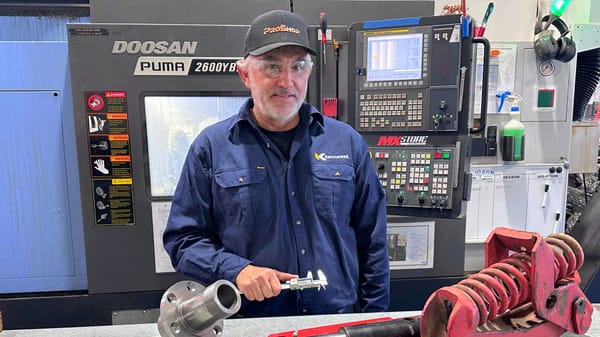How an Olympic cauldron was made – right here in Murray Bridge
Sculptor Anthony Howe’s contribution to the 2016 Rio Olympic cauldron has been widely celebrated. Lesser known is the pivotal role played by Newell Composites.

This story was originally published behind Murray Bridge News’ paywall. Paywalled stories are unlocked four weeks after publication. Can’t wait that long? Subscribe here.
Vanderlei Cordeiro de Lima climbs a staircase and stands triumphantly for a moment, flaming torch in hand, cheered by 80,000 spectators in the Maracanã and watched by 3.6 billion TV viewers around the world.
Slowly, carefully, he lowers his arms and lights the Olympic cauldron, signalling the start of the 2016 Rio games.
Drums beat as the cauldron, suspended by wires, rises into the air and assumes its place at the heart of a spinning ring of reflective discs: a shimmering, inspiring sun.
It is a magical moment.
And the sphere, the focus of all that attention, was made right here in Murray Bridge.
Here at last, as the eyes of the world move on to the Tokyo Olympics this week, is the Rio cauldron’s story.

Newell Composites operates out of a humble-looking workshop on Adelaide Road.
Founded by Dennis Newell in 1967, and now owned and operated by the August family, the company mainly produces industrial storage tanks, rainwater tanks, swimming pools – that sort of thing.
Before five years ago, its best-known product was probably Murray Bridge’s iconic Bertha the Bunyip, or perhaps Tailem Bend’s big olive.
Then came the approach from an Adelaide company that changed all that.
FCT Flames initially asked for a carrot-shaped object that would have the appearance of stainless steel and could contain a gas burner.
A few months later they updated their request: they wanted a 120-centimetre sphere.
They did not say what the object was supposed to be.
However, some online research gave managing director Robert August a few clues.
FCT had previously been involved with the Sydney, Athens, London and Beijing games.

“I knew it was something to do with the Olympics’ opening ceremony, but not the actual cauldron,” Mr August said.
“(I got suspicious) when the drawings were supplied and I noticed the item required a burner and protection from the thermal heat.”
The team at Newell made the two halves of the sphere out of fibreglass, cured at a high temperature.
Brenton Burgess from Burgess Paint ‘n’ Panel, another local business, sprayed it with a heat-resistant chrome paint that would give it a metallic shine.

Finally, they fitted a stainless steel rim around the sphere’s opening for aesthetic purposes.
Eight months after Newell Composites was first approached about making the cauldron, it was installed in Rio de Janeiro in time for its all-important debut.
Mr August only found out exactly what his team had made when the opening ceremony was broadcast live around the world on that Saturday morning, Australian time, in August 2016.
He wasn’t even watching it, but his phone lit up as he boarded a cruise ship in Brisbane that day.
American sculptor Anthony Howe’s contribution to the cauldron – an elegant ring of spinning, reflective discs – has been rightly celebrated around the world for its artistic merit.
But at the time of the games, the team at Newell was unable to talk publicly about their triumph for reasons of commercial confidentiality.
A handful of photos posted to Facebook were deleted again soon afterwards.
The only locals to hear the full story were the 80 or so guests at a Rotary Club of Murray Bridge business dinner a few months later.
I interviewed Robert and Tyson August at that dinner, but was unable to publish anything about it.
I’ve wanted to tell this story to a wider audience ever since.

Until now, the cauldron’s tale has lived on only in the pages of industry magazine Composites Australia and in the memories of those who worked on it.
They were some memories, though.
“Videos and replays were amazing to see,” Mr August said.
“Murray Bridge, and the surrounding Murraylands area, has many diverse and interesting manufacturing capabilities.
“I have been a family friend with Mayor Brenton Lewis for many years, and I know for a fact he was extremely proud of the achievement (of) the cauldron being manufactured in his region.”





